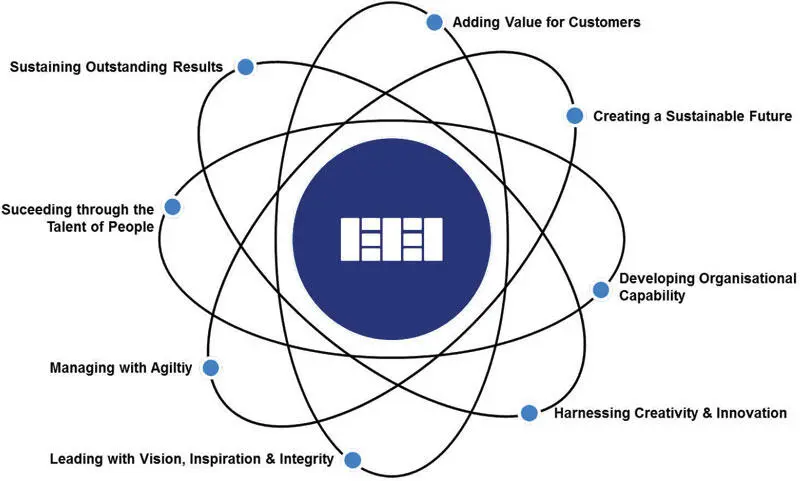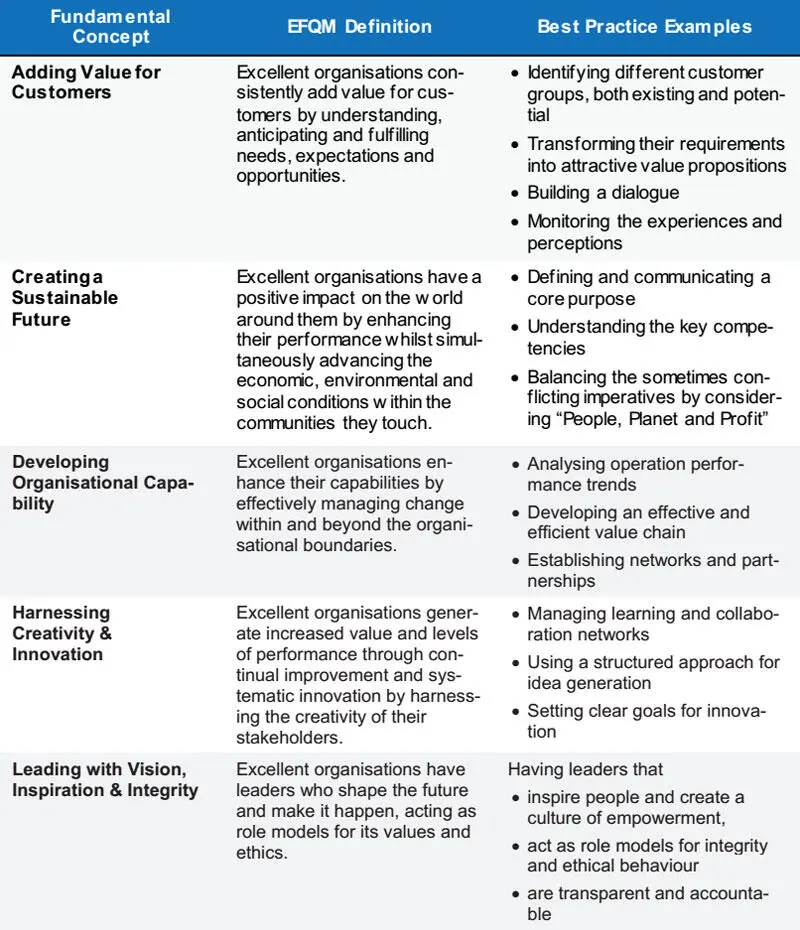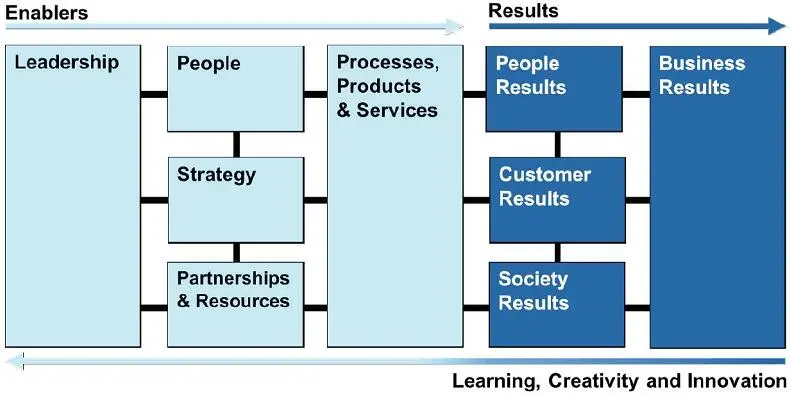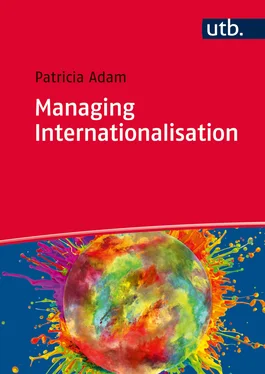Besides its predominant use in the U.S., the Baldrige model or its equivalent was used for national excellence awards in more than 20 countries worldwide in 2010, for example in Hong Kong and New Zealand. 20
The third internationally recognised model is the EFQM Excellence Model. As it represents the red thread through this textbook, it will be explained explicitly in the following chapter 1.3.
VIPs

| 1.3 |
The Approach of the EFQM Excellence Model |
The most successful and widespread holistic management model is the EFQM Excellence Model. Leaders that face an internationalisation challenge are in need of a clear structure of their organisation’s existing management system as well as of ideas for integrating new approaches and different cultures. The EFQM Excellence Model provides through its non-descriptive and structured framework a very good tool for this purpose. Consequently, its building components will be explained in detail in the following subdivisions. 21
| 1.3.1 |
Background Information: The EFQM and its Model |
The EFQM is a global non-for-profit membership foundation, established in 1988 by 14 CEOs of internationally recognised companies (Nestlé, Robert Bosch, Volkswagen et al.) with the goal of developing a management tool for increasing the competitiveness of European organisations. In alignment with its vision of “a world striving for sustainable excellence” 22the EFQM is organiser of the prestigious European Excellence Award that yearly recognises organisations for their sustainable achievements using the EFQM Excellence Model as assessment tool. To date, the EFQM records about 500 international members from many different industries and more than 50 countries. 23Its model is used by over 30 000 organisations in Europe for development and assessment purposes. 24According to a research conducted in 2010, the EFQM Excellence Model or its equivalent is used for national excellence awards in more than 35 countries worldwide, not only in European countries like Germany (Ludwig-Erhard-Preis), Finland, United Kingdom and the Russian Federation but also in Turkey and the United Arab Emirates. 25
Due to its background the EFQM Excellence Model was developed from a practical European management perspective. Accordingly, it sets a strong focus on people and sustainability. The inclusion of relevant leadership matters affecting all sorts of global organisations is one of its strong features. Keeping it up-to-date is a major prerequisite for its on-going success; therefore the model is reviewed every 3 years in a rigorous and widespread review process. The latest reviews were carried out with more than 200 representatives from academics, large organisations, EFQM partners and assessors, allowing work groups to comment and test draft versions before the final version was published. The 2013 version of the EFQM Excellence Model now emphasises emerging trends like innovation, risk management and corporate governance. The in-depth revision achieved also a full integration of its main building blocks: the 8 fundamental concepts, the 9 model criteria and the RADAR assessment tool.
| 1.3.2 |
The Fundamental Concepts of Excellence |
Every management model is based on key concepts that explain the underlying management philosophy. These concepts provide important guidance on the interpretation of model criteria in case they are not self-explanatory. Before using any kind of model it is always advisable to compare its basic philosophy with one’s own because incompatibilities in this respect can reduce the usefulness of a tool considerably.

Figure 1-7: EFQM Fundamental Concepts of Excellence 26
The EFQM Excellence Model supports any kind of organisation in its endeavour to attain excellence with the goal of meeting or exceeding the expectations of its stakeholders by achieving and sustaining superior levels of performance. The essential foundation of this quest is built by 8 underlying principles called the Fundamental Concepts as depicted in Figure 1-7.

Figure 1-8: EFQM Fundamental Concepts: Definitions and Best Practices 27
Each Fundamental Concept of Excellence is defined against the backdrop of a management approach of an excellent organisation. These definitions are augmented by aspects of what excellent organisations do to transfer these principles into practical activities. The main definitions and some of their constitutive best practices are specified in Figure 1-8. The management approach described in the Fundamental Concepts is cast in a structure of a holistic management model with 9 criteria: the EFQM Excellence Model.
| 1.3.3 |
The EFQM Excellence Model Framework 2013 |
The EFQM Excellence Model 2010 offers through its non-descriptive framework a guiding structure for any kind of organisation striving for excellence. It is presented in Figure 1-9. The nine criteria and their subdivisions allow depicting precisely an organisation’s way of offering value (“enablers”) and the resulting goal attainment (“results”).

Figure 1-9: The EFQM Excellence ModelFramework2013 28

Figure 1-10: Definitions ofthe EFQM Enabler Criteria 29
The five enabler criteria on the left side of the model cover what an organisation does to fulfil the various expectations of its stakeholders and how it does it. They consist of the criteria 1 Leadership, 2 Strategy, 3 People, 4 Partnerships & Resources and 5 Processes, Products and Services. The results stem from the enablers and depict what the organisation achieves. The balanced view on results is expressed by the four criteria 6 Customer Results, 7 People Results, 8 Society Results and 9 Business Results. As any excellent organisation is a learning organisation, the dynamic of continuous improvement through feedback is represented by the arrow at the base of the model stating “Learning, Creativity and Innovation”. Each criterion is clearly defined in order to explain its general meaning. An overview of the criteria definitions is provided in Figure 1-10(for enablers) and Figure 1-11(for results).

Figure 1-11: Definitions of the EFQM Results Criteria 30
The high level definitions of the criteria only allow a very rough structure of a management system. For assessing the maturity of an organisation as well as its strengths and weaknesses, a more detailed approach is necessary. Therefore, the nine criteria are subdivided in criterion parts and these are further elaborated in guidance points. The 32 criterion parts describe different facets of what an excellent organisation typically does in the area of the defined criterion and what therefore should be considered during an assessment. On the third and lowest level of the model, the guidance points provide tangible best practice examples of how to implement the ideas. These guidance points link the EFQM Excellence Model to the Fundamental Concepts. Some of them provide an adaption of one part of a Fundamental Concept to fit the specific context of the criterion part. Other guidance points repeat the text from the Fundamental Concept precisely. Through the guidance points, the structure of the model allows to grasp connections between the different criteria and by that to identify management approaches that are able to integrate several goals at once. This adds another dimension to the otherwise two-dimensional model. These links are depicted by the connecting lines in the EFQM Excellence Model Framework. A graphic example of the EFQM levels is provided in Figure 1-12.
Читать дальше


















